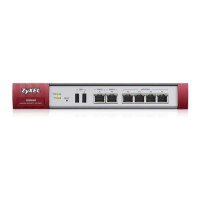Chapter 22 Virtual Servers
ZyWALL Series CLI Reference Guide
201
22.3.6 Virtual Server Load Balancing Commands
The following table describes the virtual server load balancing commands..
Least-Connection The Zyxel Device assigns the server with the least number of current connections.
Source Hashing / Source IP The Zyxel Device assigns a server by checking a static hash table, which
permanently maps each client IP address to a specific real server.
Servers are mapped to new client IP addresses in the reverse order the servers were
added to the rule (Last In First Out). Each server is added N times during each
sequence, where N is equal to the server’s weight.
For example, if you have two servers A, and B, with weights 1 and 2, the servers are
mapped to new client IP addresses in the hash table in the following order:
Source_IP_Hash1 = Server B
Source_IP_Hash2 = Server B
Source_IP_Hash3 = Server A
Source_IP_Hash4 = Server B
Source_IP_Hash5 = Server B
Source_IP_Hash6 = Server A
Table 101 Virtual Server Load Balancing Algorithms
ALGORITHM DESCRIPTION
Table 102 Virtual Server Load Balancing Commands
Command
DESCRIPTION
ip virtual-server
load-balancer name
Enters subcommand mode for the specified load balancing rule.
If you rule does not currently exist, then the Zyxel Device creates the rule.
The name must consist of 1–31 characters, and may contain letters, numbers, and
the following special characters: - (hyphen), _ (underscore).
[no] activate
Enables or disables the load balancing rule.
virtual-service
interface
interface_name
external-ip
{address|object}
external-port
port protocol
{tcp|udp}]
Links the load balancing rule to an incoming interface, an external IPv4 address,
and a port. Incoming requests to the IP4 address and port are processing by the
load balancing rule.
interface_name: The name of a device interface, for example wan1. The interface
must be one of the following types: Ethernet, VLAN, bridge, PPPoE/PPTP.
address|object: The IPv4 address of the virtual server. You can enter the IP
address manually, for example: 192.168.100.100, or you can enter the name of an
IPv4 interface object.
port: The TCP or UDP port to bind this rule to. Valid range is 1–65535.
virtual-service
interface
interface_name
external-ip
{address|object}
external-service
service
Links the load balancing rule to an incoming interface, an external IPv4 address,
and a port. Incoming requests to the IP4 address and port are processing by the
load balancing rule.
interface_name: The name of a device interface, for example wan1. The interface
must be one of the following types: Ethernet, VLAN, bridge, PPPoE/PPTP.
address|object: An IPv4 address bound to the interface. You can enter the IP
address manually, for example: 192.168.100.100, or you can enter the name of an
IPv4 interface object.
service: The name of a service object, for example SMTP. For details on creating
service objects, see Chapter 53 on page 468.

